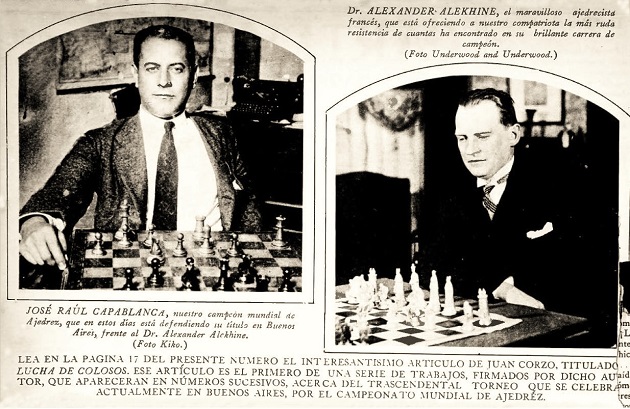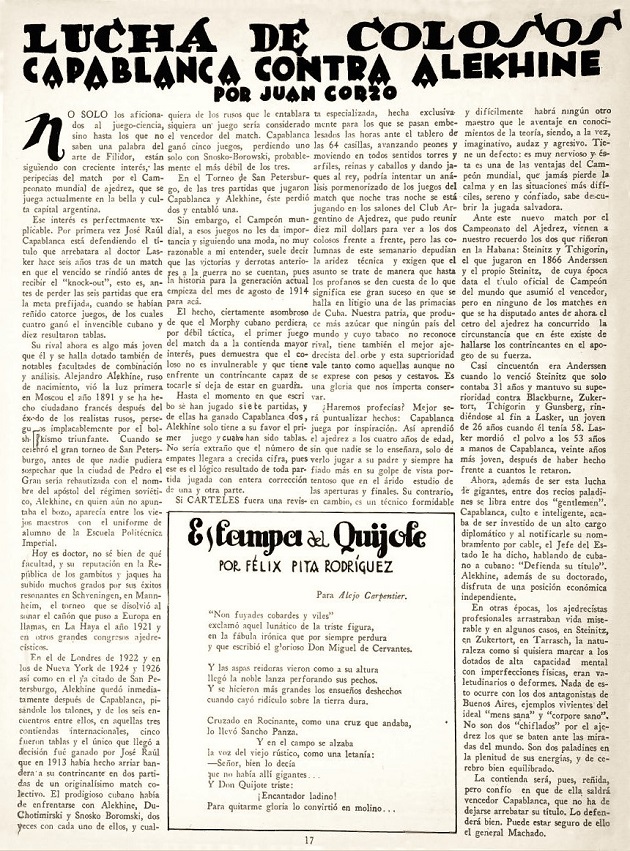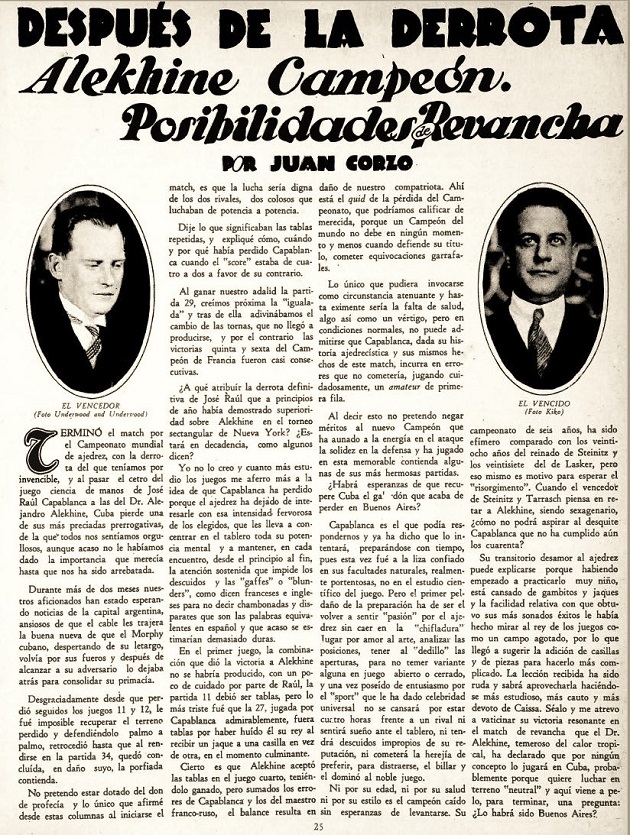Chess Notes
Edward Winter
When contacting us by e-mail, correspondents are asked to include their name and full postal address and, when providing information, to quote exact book and magazine sources. The word ‘chess’ needs to appear in the subject-line or in the message itself.
| First column | << previous | Archives [176] | next >> | Current column |
11243. Spassky v Fischer, 1972
An addition to Gaffes by Chess Publishers and Authors has been submitted by Javier Asturiano Molina (Murcia, Spain):
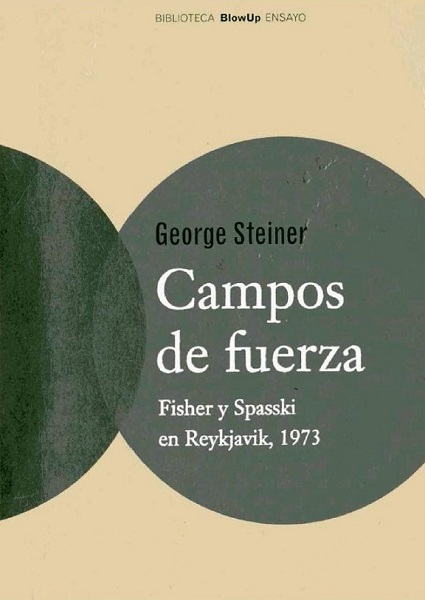
This translation of Steiner’s well-known book was published in Madrid in 2004.
11244. Who? (C.N. 11238)
From page 337 of Inteligências em Confronto: Campeonatos Mundiais de Xadrez by Rubens Filguth (Porto Alegre, 2006):
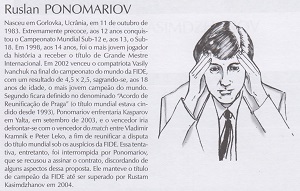
11245. A problem by Bernard (C.N. 11242)
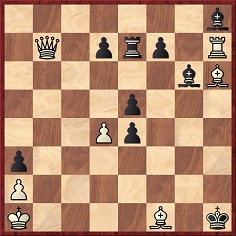
This very tricky three-mover was shown in C.N. 11242. The solution given on page 290 of the July 1905 BCM was 1 Qa6, but a correction appeared on page 329 of the August 1905 issue:

11246. A game against Death
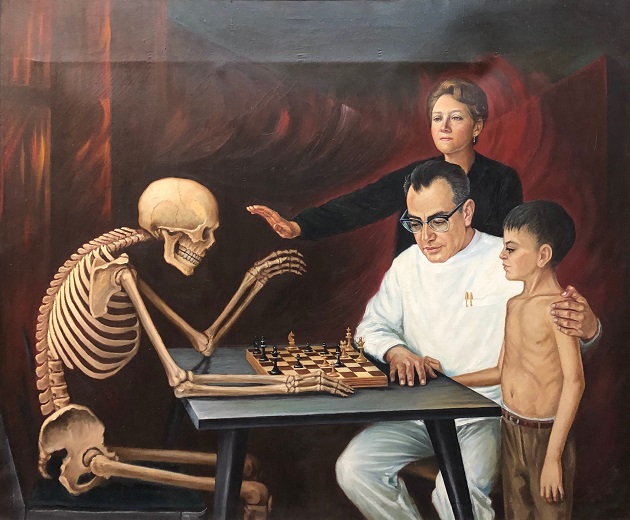
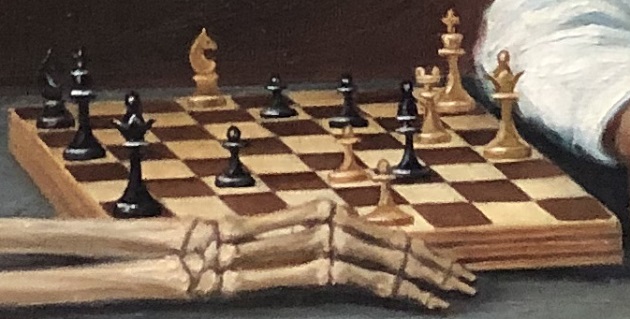
Olivia Segura Ortiz (Mexico City) has sent us this photograph of a painting commissioned by her grandfather, Dr Alfredo Lejarza, to depict his fight for the life of a dangerously ill boy in a game of chess against Death. Our correspondent’s grandmother is calling on Death to stop and to allow the boy to live.
This information corrects what appeared on page 275 of the Whitsun 1963 CHESS, an item which is in our feature article Chess and Ghosts:

11247. Guerra Boneo v De Witt (C.N. 8576)
Eduardo Bauzá Mercére (New York, NY, USA) notes that the game discussed in C.N. 8576 was played in the eighth round of the Torneo Mayor in Buenos Aires on 17 July 1926. He provides this cutting from page 2 of La Nación, 20 July 1926:
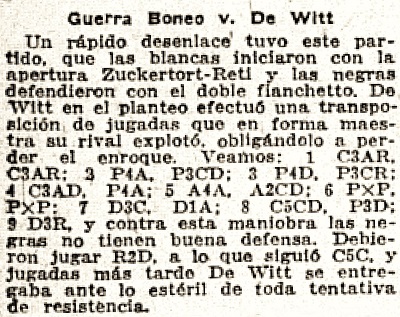
11248. Isidor Gunsberg
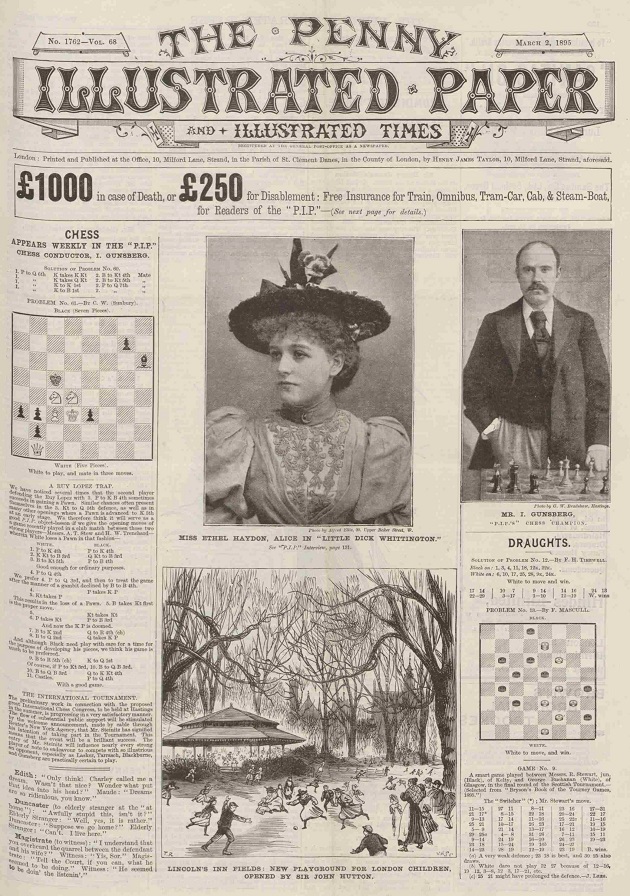
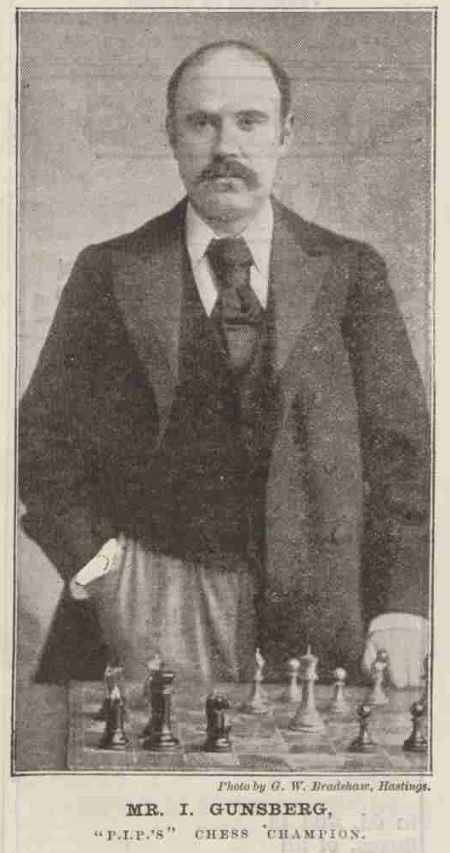
11249. James Mortimer
C.N.s 3366 and 3368 (see pages 218-220 of Chess Facts and Fables) presented parts of ‘Some Chess Players I Have Met’ by James Mortimer from pages 173-178 of the May 1905 BCM. On pages 293-297 of the August 1905 issue he contributed ‘Some More Chess Players I Have Met’.
Below is a profile of Mortimer by P.W. Sergeant on pages 155-160 of the April-September 1910 edition of the English Illustrated Magazine:
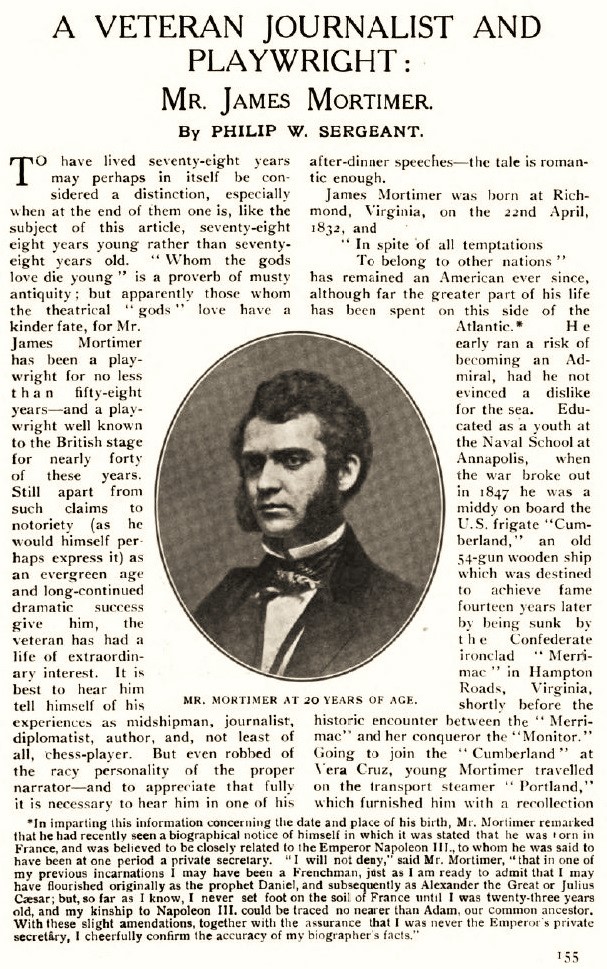
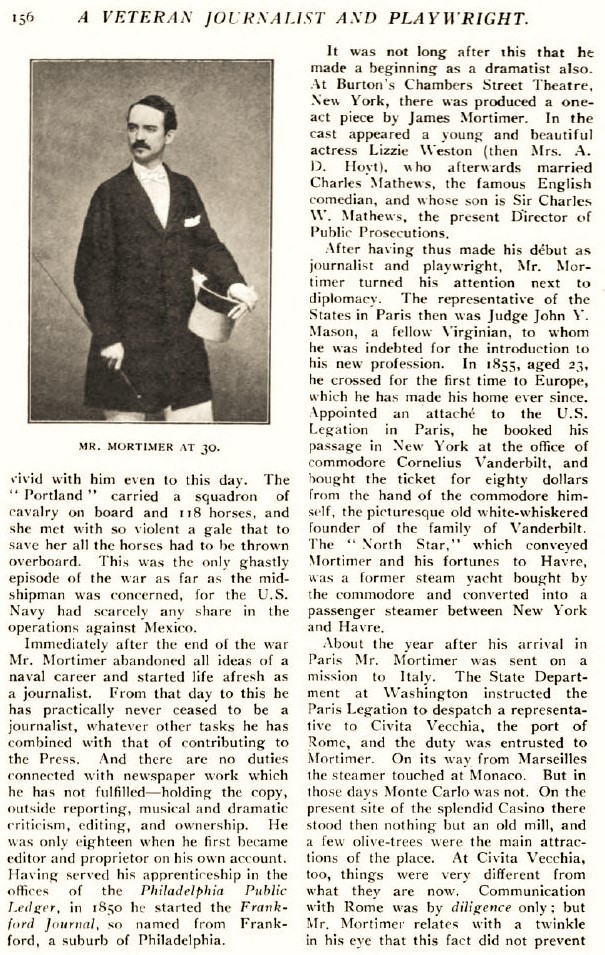
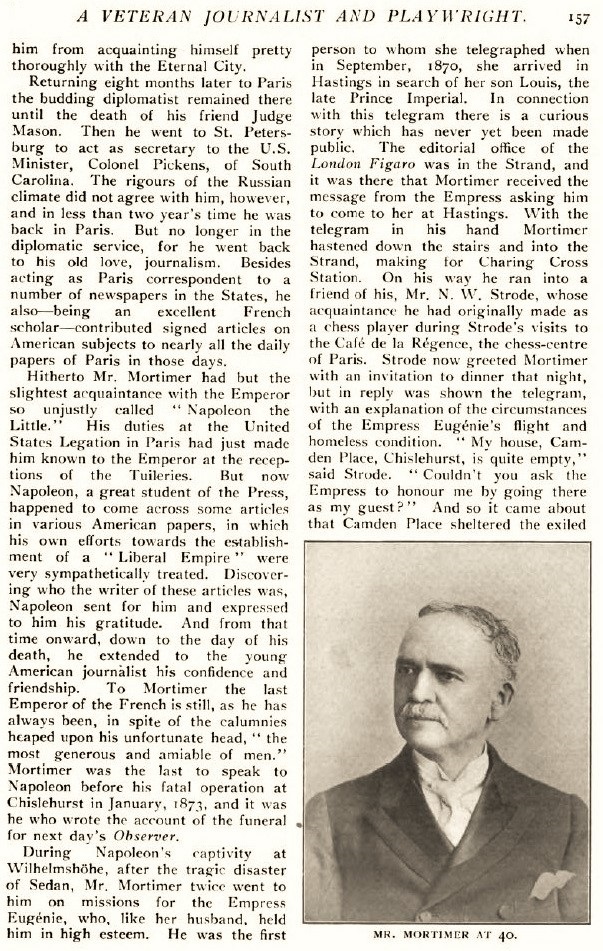
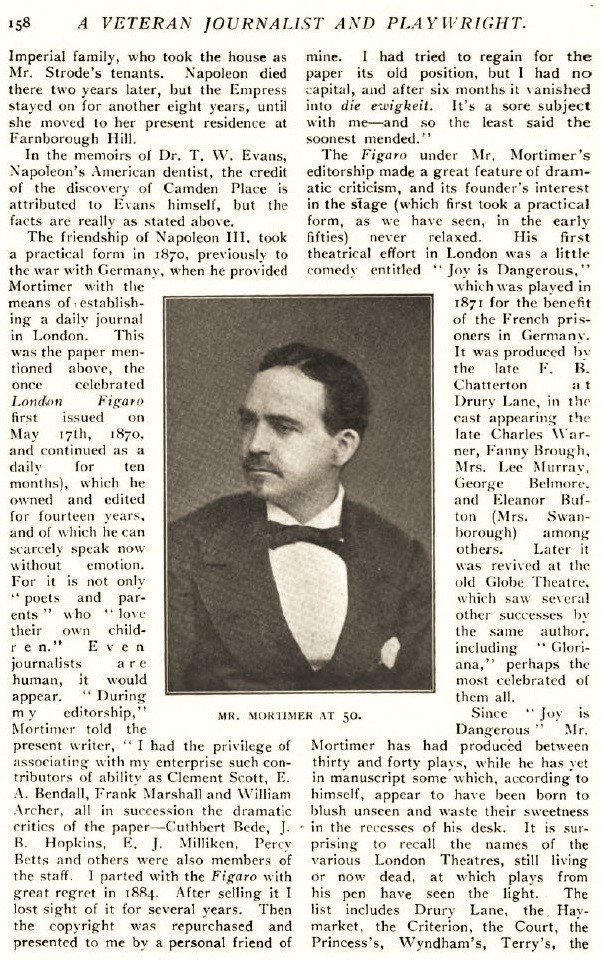
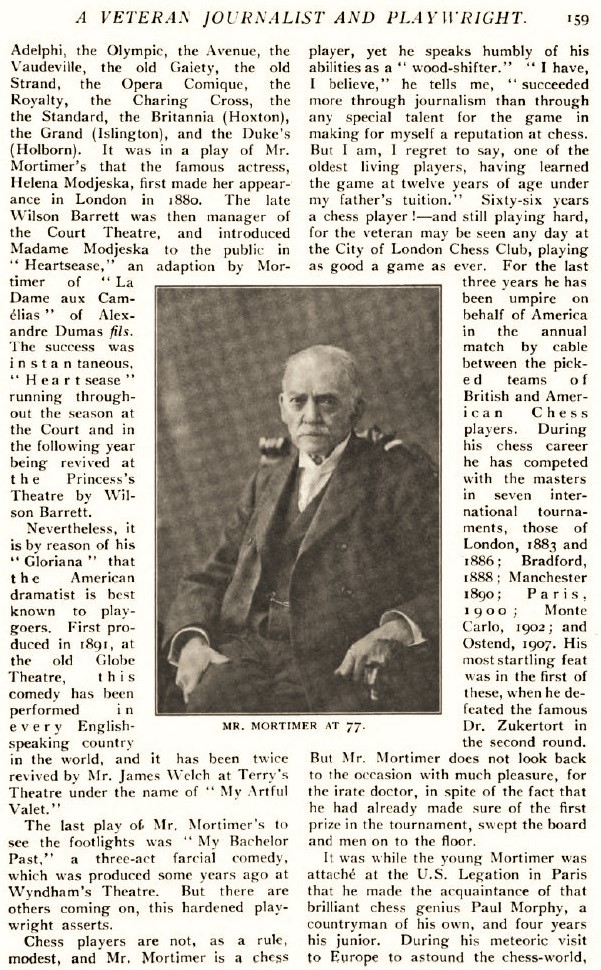
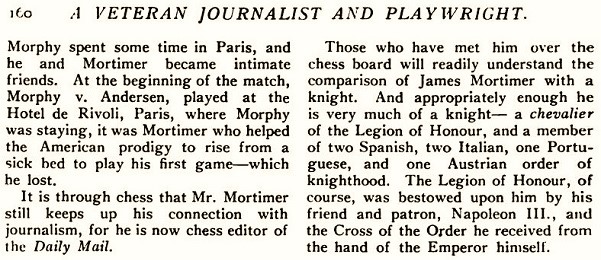
A number of points concerning Mortimer will be discussed in future items, including his year of birth (1832 or 1833?).
11250. Further information about James Mortimer
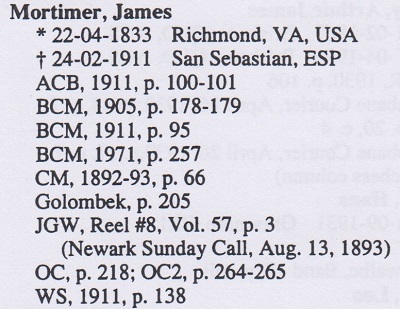
Chess Personalia by Jeremy Gaige (unpublished 1994 edition)
On page 155 of the English Illustrated Magazine, April-September 1910 (C.N. 11249), P.W. Sergeant wrote that James Mortimer was aged 78 at that time, having been born on 22 April 1832. A footnote on the same page stated that the information had been imparted by Mortimer himself. This would mean that when he died, in February 1911, he was aged 78.
Quite apart from secondary sources, primary ones offer much on Mortimer that is contradictory, and a non-exhaustive list follows.
Date of birth:
- ‘Born at Richmond, Virginia, on 2 April 1833.’ Chess Monthly, November 1892, page 66;
- ‘Born 22 April 1833, at Richmond, Virginia.’ BCM, May 1905, page 178;
- ‘Born at Richmond, Virginia, in 1832.’ The Times, 25 February 1911, page 11;
- ‘Born at Richmond, Virginia, USA, on 22 April 1833.’ BCM, March 1911, page 95;
- ‘Geb. am 2. April 1833 zu Richmond in Virginia.’ Deutsche Schachzeitung, April 1911, page 126;
- ‘At Richmond, Virginia, on 22 April 1832.’ American Chess Bulletin, May 1911, page 100;
- ‘Geb. 2. April 1833 zu Richmond in Virginia.’ Wiener Schachzeitung, June 1911, page 138.
Date of death:
- ‘Died at San Sebastián, Spain early yesterday morning. ... 79 years of age.’ Daily Mail, 25 February 1911, page 3;
- ‘Died [in San Sebastián] at 2 o’clock yesterday morning.’ The Times, 25 February 1911, page 11;
- ‘Agé de 79 ans.’ La Stratégie, February 1911, page 71;
- ‘Died at San Sebastián on Friday, 24 February. ... His great age – 79 years.’ BCM, March 1911, page 95;
- ‘Am 24. Februar ist ... James Mortimer im Alter von 79 Jahren gestorben.’ Deutsches Wochenschach, 5 March 1911, page 85;
- ‘Has passed away at the great age of 79.’ Chess Amateur, April 1911, page 195;
- ‘Starb am 27 Februar.’ Deutsche Schachzeitung, April 1911, page 126;
- ‘Am 27. Februar 1911 ist ... James Mortimer ... in San Sebastián gestorben.’ Wiener Schachzeitung, June 1911, page 138.
The BCM’s obituary was self-contradictory: if Mortimer was born on 22 April 1833 and died on 24 February 1911, he reached the age of 77, not 79. The oft-seen ‘aged 79’ cannot be correct in any eventuality.
In view of P.W. Sergeant’s comment about having corroboration from Mortimer himself, 22 April 1832 is by far the most likely birth-date, and particularly since it was also given on page 100 of the May 1911 American Chess Bulletin alongside this remark about a forthcoming international cable match:
‘In a recent letter to the Bulletin, Mr Mortimer wrote: “The second day of the match, 22 April, will be my 79th birthday, and I hope the boys will make me a present of an American victory on the day I enter upon my 80th year”.’
The full American Chess Bulletin obituary:
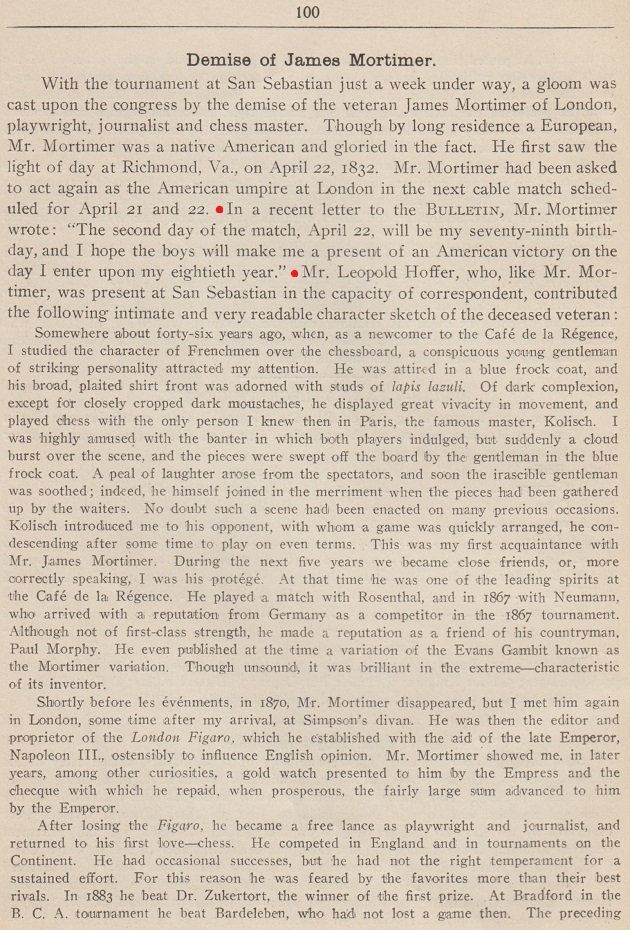
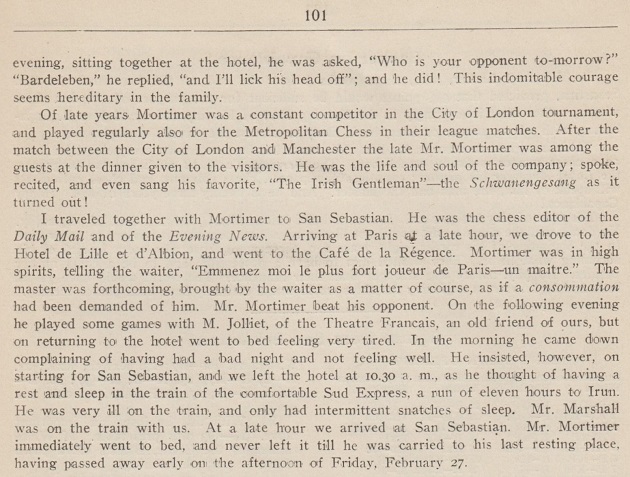
In the final line, the date is incorrect; the last Friday
of the month was 24 February. The reference to ‘afternoon’
is contradicted by the above-mentioned obituaries in the Daily
Mail and The Times.
Page 7 of the Daily Mail, 27 February 1911 reported that Mortimer’s funeral had taken place in San Sebastián on 25 February:
‘The chess masters now here sent a wreath with the inscription, “With deepest sympathy from the competitors in the San Sebastián Chess Tournament”.’
11251. A three-mover by Mortimer
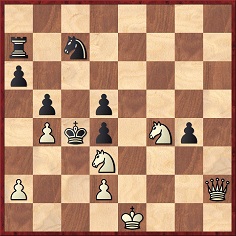
Mate in three
James Mortimer gave this problem in his chess column in the Daily Mail, 12 December 1906, page 8. When reproducing it on page 195 of the Chess Amateur, April 1911, P.H. Williams called it a composition which Mortimer ‘was never tired of showing to anybody who would look at it’.
Another comment on Mortimer by Williams in the same Chess Amateur article:
‘He composed a few problems, of the old-fashioned school, but his knowledge of modern problem construction was quite rudimentary, though he probably would never have admitted it.’
11252. The dead and the living
James Mortimer’s introductory comments in his article ‘Some More Chess Players I Have Met’ on pages 291-297 of the August 1905 BCM:
‘... I now realize that the historian can assert anything he likes about the dim and distant past, but, in writing of the present, is obliged to stick to the simple and beautiful truth. De mortuis nil nisi bonum is a maxim frequently ignored, when you are telling a tale about a Mr de Mortuis who is permanently mortuised, and not in a position to look after you with a big stick, or to commence an action for libel against your publisher. This is a source of great comfort, and you give your mortuis plenty, with a lofty contempt of the consequences.
But when you tackle Mr de Vivis, etc., it is a totally different pair of boots, especially if they happen to be large, thick, hob-nailed, aggressive, fatal, lethal boots. How, then, am I to say what I think of living chess players, without giving rise to a trial of physical strength in which, of course, I should be top dog, but I should nevertheless deplore, as a member of the Society for the Prevention of Cruelty to Animals? Everybody knows that the genus irritabile vatum is of a positively angelic temper, compared with the genus irritabile chess player. I have met chess players whom I have heard others praise, and that highly – not to speak it profanely – for their gentle ways and winning politeness. But I have noticed that these same lamb-like woodshifters are not usually endowed in the same degree with losing politeness, and plainly show their antipathy to being beaten across the board.’
11253. A three-mover by Mortimer (C.N. 11251)
Below is the problem as published in James Mortimer’s chess column in the Daily Mail, 12 December 1906, page 8:
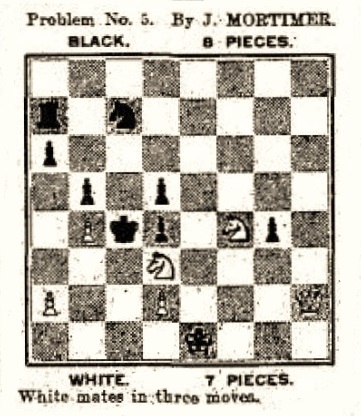
Michael McDowell (Westcliff-on-sea, England) reports that it is the only composition by Mortimer in the WinChloe database, where the original source specified is the periodical Knowledge. That was in C.D. Locock’s column on page 99 of the 1 May 1891 edition:
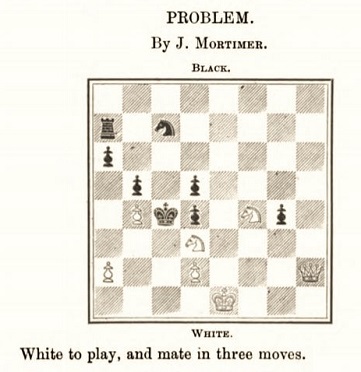
The first of the reproductions listed in the WinChloe database is page 288 of the September 1891 International Chess Magazine. We note that Steinitz’s periodical gave as its source the Hereford Times, without a date.
11254. Anderssen and Anderssen
From page 14 of Veliki šahovski turnirji 1851-1911 by Janez Stupica (Ljubljana, 2013):
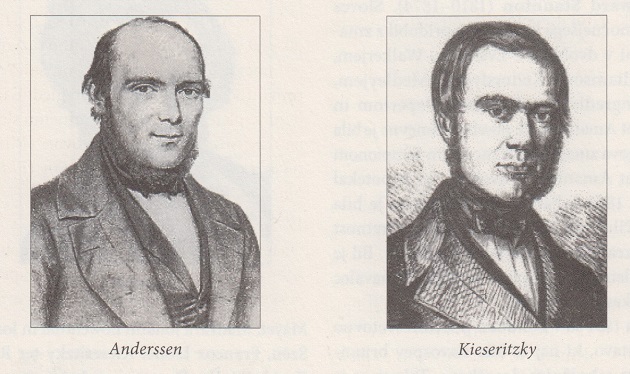
C.N. 9069 drew attention to another misidentification in the book: on page 271 Kaiser was named as Chajes.
11255. The Evans Gambit
The start of an entry, by W.R. Hartston, on page 111 of The Encyclopedia of Chess edited by Harry Golombek (London, 1977):

The description ‘a gift of the gods to a languishing chess world’ is often said to have been written ‘once’ by someone, but what are the particulars?
The question was raised by Leonard Reitstein on page 197 of the July 1965 BCM, in D.J. Morgan’s Quotes and Queries column, but the only source offered was page 6 of the ninth edition of Modern Chess Openings by Walter Korn and John W. Collins (London, 1957):

Three snippets have been shown in The Evans Gambit, based on the existence of German-language websites which ascribe to Tartakower this observation on the Gambit: ‘Dieses blendende Angriffsspiel ist dafür erfunden worden, die Menschen zu dem Glauben zu veranlassen, dass die Schachkunst ein Geschenk der Götter ist’.
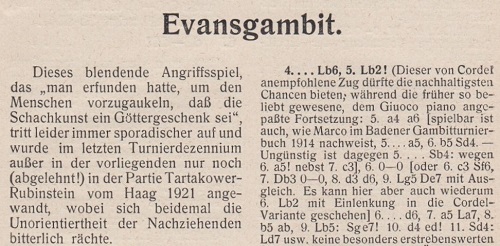
Die Hypermoderne Schachpartie by S. Tartakower (Vienna, 1924), page 173

La moderna partida de ajedrez by S. Tartakower, volume one (Buenos Aires, 1959), page 161
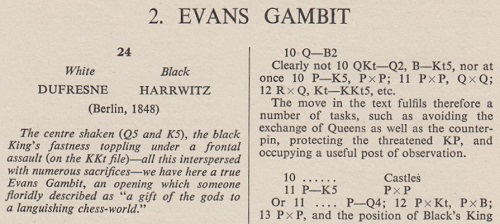
500 Master Games of Chess by S. Tartakower and J. du Mont (London, 1952), page 29.
11256. The death of James Mortimer (C.N. 11250)
Christian Sánchez (Rosario, Argentina) has forwarded two puzzling cuttings:
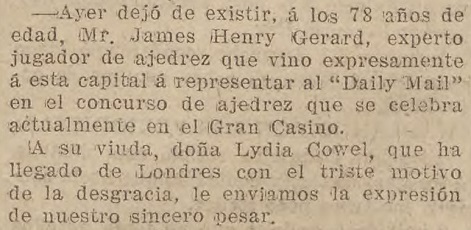
El Pueblo Vasco (San Sebastián), 25 February 1911, page 1
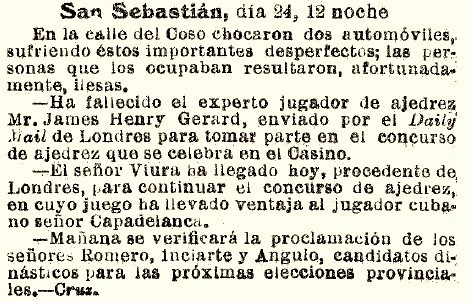
La Vanguardia (Barcelona), 25 February 1911, page 8
We can offer no explanation as to why the Daily Mail’s deceased chess correspondent was identified as James Henry Gerard. His widow was named by El Pueblo Vasco as Lydia Cowel; an Internet search for James Mortimer yields a number of pages which also mention Lydia Cowell in connection with theatrical activities.
11257. Three-movers (C.N.s 11242 & 11245)
The problems by Marín and Bernard were published on page 7 of the Norwich Mercury, 1 March 1905. The newspaper reported that Bernard’s won second prize ex aequo with this composition by A.F. Mackenzie:
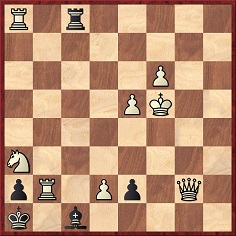
Mate in three.
11258. Masters of the past
Another addition to Chess: The Greatest comes from a report by Miro Radojčić on his conversation with M. Najdorf at the 1968 Olympiad in Lugano. Najdorf asserted:
‘Whether the great ones of the past played better or not is hardly the real question. Nobody could answer that. But what one could say and what is certainly true is that grandmasters from past generations played much more interesting chess than those of today. Theirs were creative minds in complete contrast with the majority of contemporary stars who are rather hard workers and imitators more than anything else.’
Source: Chess Life, January 1969, page 9.
11259. Śliwa v Bronstein
From an entry by Wolfgang Heidenfeld on page 148 of The Encyclopedia of Chess edited by Harry Golombek (London, 1977):

For ease of reference, the score as given in the Encyclopedia and, for instance, on page 47 of Chess Review, February 1958: 1 d4 f5 2 g3 Nf6 3 Bg2 g6 4 Bg5 Bg7 5 Nc3 Nc6 6 Qd2 d6 7 h4 e6 8 O-O-O h6 9 Bf4 Bd7 10 e4 fxe4 11 Nxe4 Nd5 12 Ne2 Qe7 13 c4 Nb6 14 c5 dxc5 15 Bxc7 O-O 16 Bd6 Qf7 17 Bxf8 Rxf8 18 dxc5 Nd5 19 f4 Rd8 20 N2c3 Ndb4 21 Nd6 Qf8 22 Nxb7 Nd4 23 Nxd8 Bb5 24 Nxe6 Bd3 25 Bd5 Qf5 26 Nxd4+ Qxd5 27 Nc2 Bxc3 28 bxc3 Qxa2 29 cxb4 Resigns. Some sources have a slightly different order for the opening moves.
Information will be welcomed on where Lauterbach wrote about the game and whether his term was, as may be expected, ‘Die Unsterbliche Verlustpartie’. Heidenfeld mentioned Śliwa v Bronstein on page 271 of the September 1965 BCM, calling it the ‘immortal loss’.
11260. Capablanca and Alekhine
From pages 6 and 17 of the 9 October 1927 issue of Carteles magazine:
11261. Knights of the Round Table
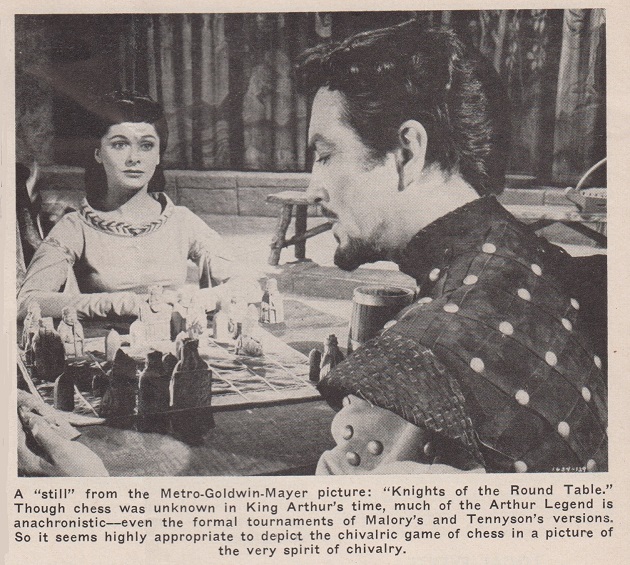
Chess Review, February 1954, page 38
Page 200 of Chess in the Movies by Bob Basalla (Davenport, 2005) identified Robert Taylor’s opponent as Ava Gardner, instead of Maureen Swanson.
11262. Calder-Smith v Katz
From page 126 of A Guide to Chess Endings by Max Euwe and David Hooper (London, 1959):
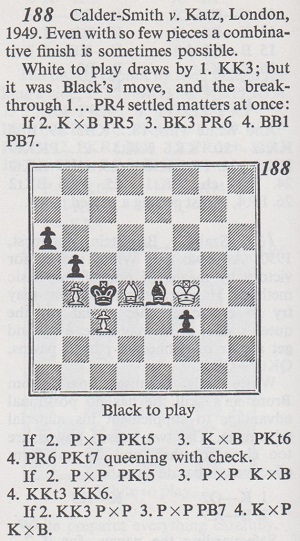
Not having seen the game-score in any database, we show its appearance, undated, on page 289 of the British Chess Federation’s Year Book 1949-1950 edited by J.H. van Meurs (Leeds, 1950):
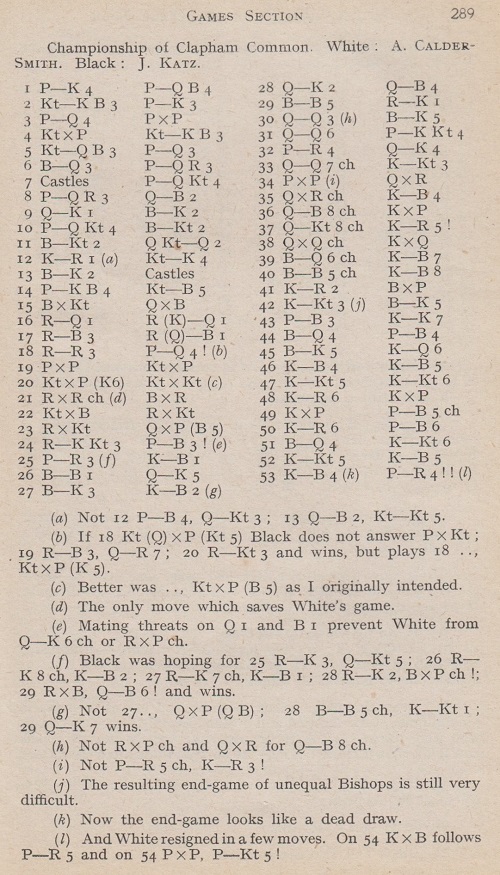
1 e4 c5 2 Nf3 e6 3 d4 cxd4 4 Nxd4 Nf6 5 Nc3 d6 6 Bd3 a6 7 O-O b5 8 a3 Qc7 9 Qe1 Be7 10 b4 Bb7 11 Bb2 Nbd7 12 Kh1 Ne5 13 Be2 O-O 14 f4 Nc4 15 Bxc4 Qxc4 16 Rd1 Rfd8 17 Rf3 Rac8 18 Rh3 d5 19 exd5 Nxd5 20 Nxe6 Nxc3 21 Rxd8+ Bxd8 22 Nxd8 Rxd8 23 Rxc3 Qxf4 24 Rg3 f6 25 h3 Kf8 26 Bc1 Qe4 27 Be3 Kf7 28 Qe2 Qf5 29 Bc5 Re8 30 Qd3 Be4 31 Qd6 g5 32 h4 Qe5 33 Qd7+ Kg6 34 hxg5 Qxg3 35 Qxe8+ Kf5 36 Qc8+ Kxg5 37 Qg8+ Kh4 38 Qxg3+ Kxg3 39 Bd6+ Kf2 40 Bc5+ Kf1 41 Kh2 Bxg2 42 Kg3 Be4 43 c3 Ke2 44 Bd4 f5 45 Be5 Kd3 46 Kf4 Kc4 47 Kg5 Kb3 48 Kh6 Kxa3 49 Kxh7 f4+ 50 Kh6 f3 51 Bd4 Kb3 52 Kg5 Kc4 53 Kf4 a5 and wins.
11263. Potter and the Encyclopaedia Britannica
Fabrizio Zavatarelli (Milan, Italy) draws attention to this excerpt from the ninth edition of the Encyclopaedia Britannica, on page 593, with respect to The Knight Challenge:
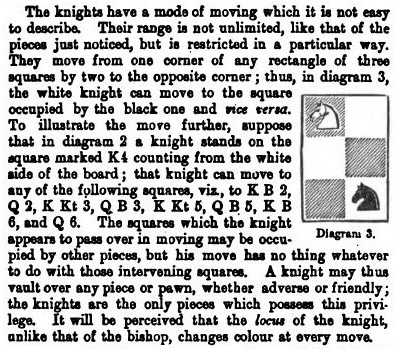
The article on chess, published in the mid-1870s, was signed ‘W.N.P.’, i.e. William Norwood Potter. His obituary on page 180 of the April 1895 BCM called it ‘masterly’; page 226 of the April 1895 Chess Monthly stated that Potter edited the article ‘together with Steinitz and Zukertort’.
11264. The death of James Mortimer (C.N.s 11250 & 11256)
C.N. 11256 showed that two Spanish newspapers dated 25 September 1911 mysteriously referred to James Mortimer as ‘Mr James Henry Gerard’.
Javier Asturiano Molina (Murcia, Spain) reports that he has found Mortimer’s death certificate, dated 24 February 1911, in the Registro Civil of San Sebastián:
‘... D. James Enrique Gerardo Mortimer, natural de Virginia (Estados Unidos de América), de setenta y ocho años de edad, periodista, domiciliado accidentalmente en esta Capital, Calle de Zubieta, Hotel de Londres, ha fallecido á las dos y media de hoy, en el referido domicilio, á consecuencia de bronco pneumonía.’
The certificate was signed by the juez municipal the same day (‘á las diez y seis del día veinticuatro de Febrero de mil novecientos once’).
11265. Facts, non-facts and interpretations
First, two extracts from The Human Side of Chess by Fred Reinfeld (London, 1953):
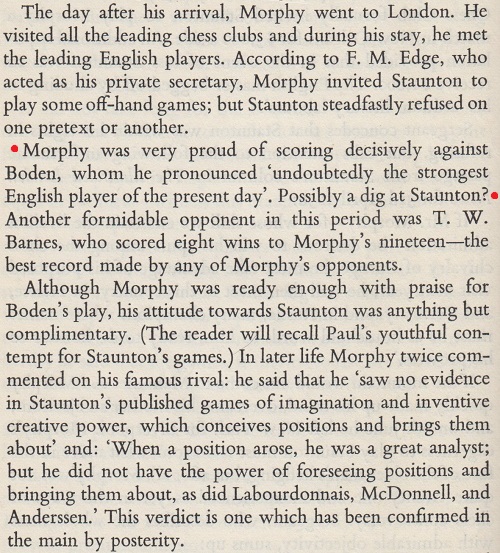
Page 64
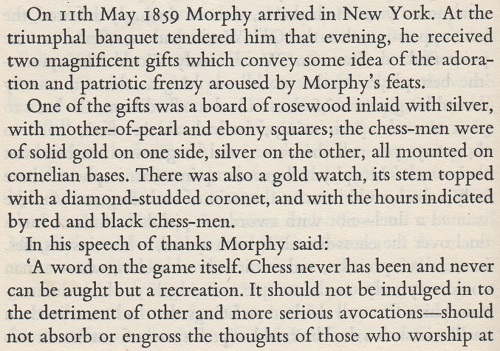
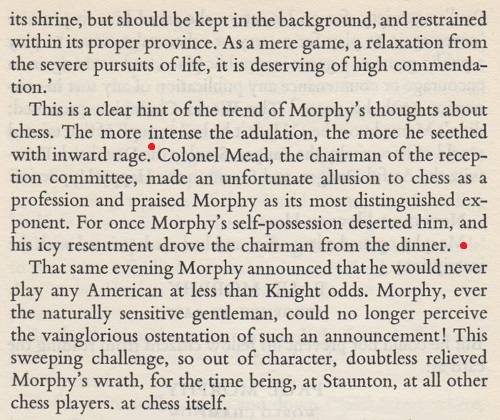
Pages 72-73
From a review of Reinfeld’s book on page 3 of CHESS, October 1953:
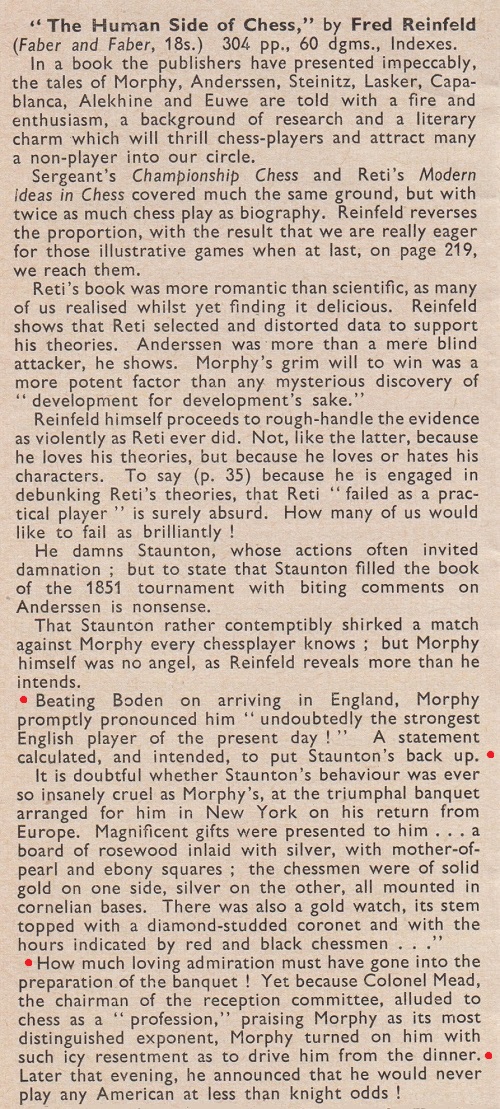
The specific remark by Morphy about Boden being ‘undoubtedly the strongest English player of the present day’ was not made ‘promptly’ by Morphy after his arrival in England in June 1858. He wrote it in his New York Ledger column of 31 March 1860 in notes to a McDonnell v Labourdonnais game (which had begun 1 e4 e5 2 Bc4 Nf6 3 d4):
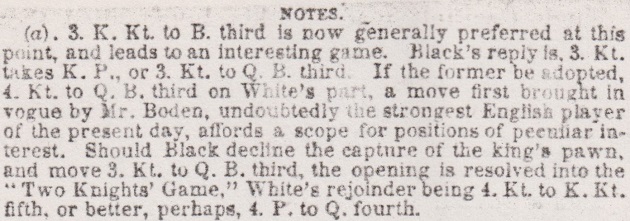
Also concerning Boden, below is a comment by F.M. Edge on page 73 of his book on Morphy (New York, 1859):
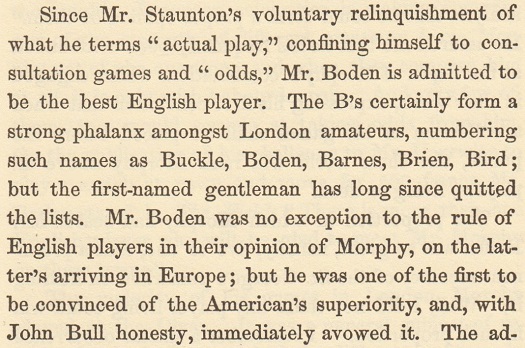
The entire 1859 banquet story involving Colonel Mead was dismissed by David Lawson on pages 213-214 of his 1976 monograph on Morphy: ‘No such incident occurred.’ On page 174 Lawson commented regarding The Human Side of Chess: ‘Reinfeld is frequently in error in his facts and assessments.’
11266. More Capablanca photographs
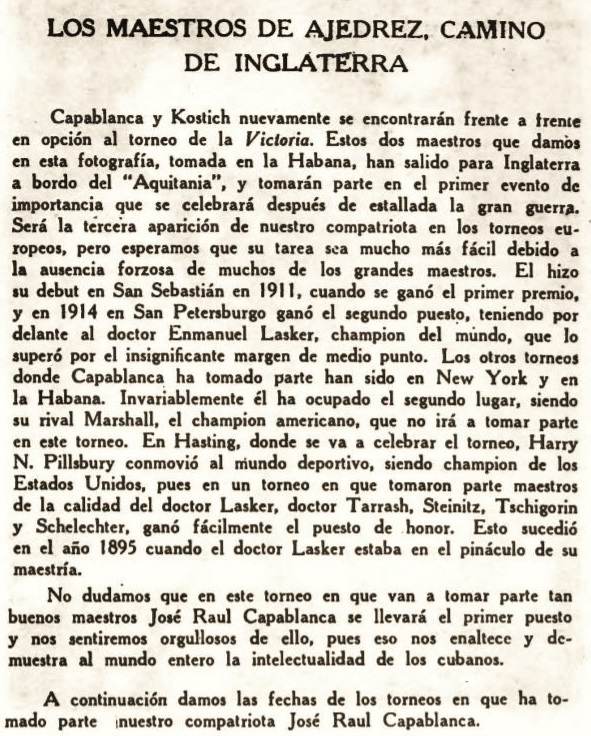
Carteles, August 1919, page 58
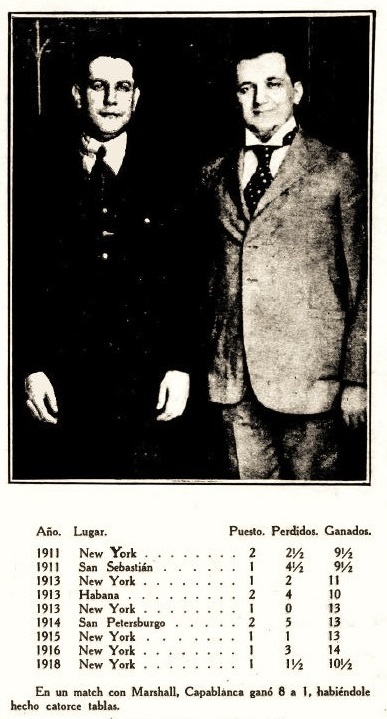
Carteles, August 1919, page 59
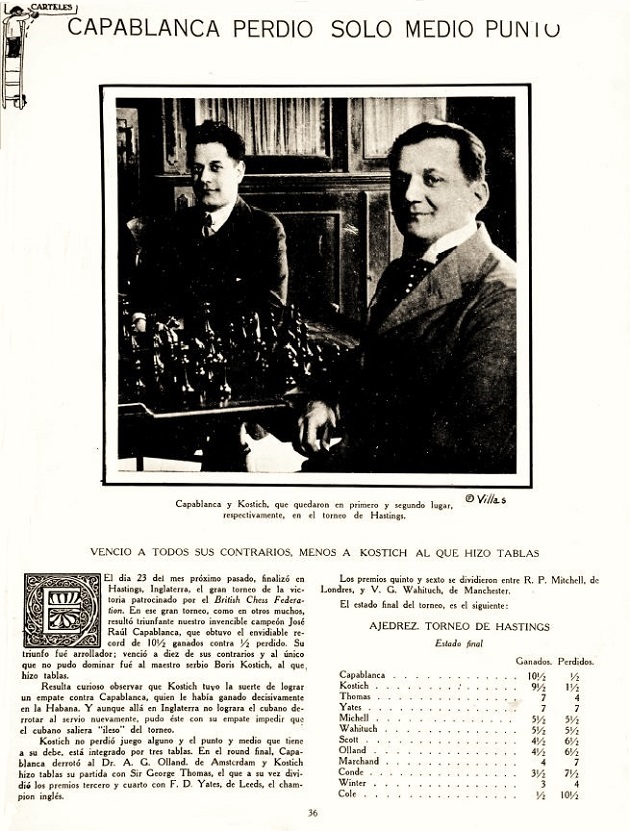
Carteles, September
1919, page 36
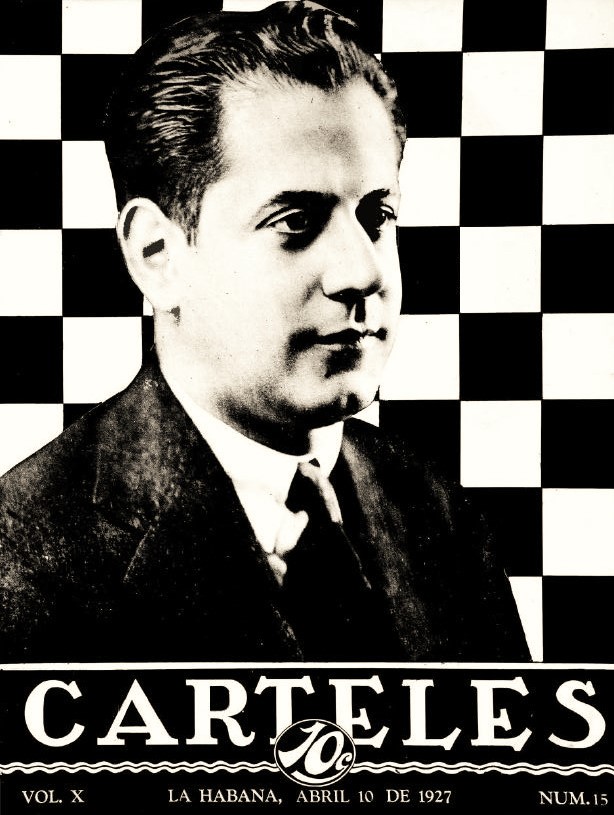
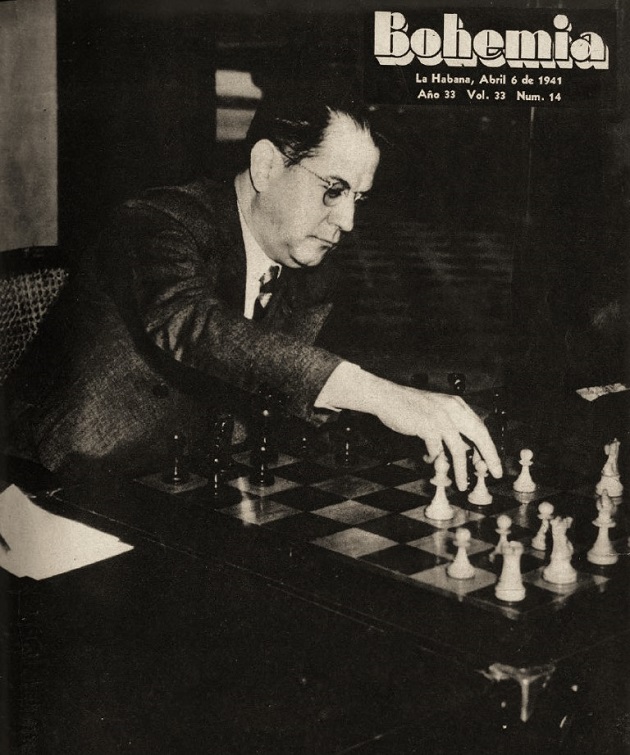
11267. Bobby Fischer and Barbra Streisand (C.N. 4966)
Ronald Young (Bronx, NY, USA) notes an interview with Barbra Streisand on pages 79-107 and 193-200 of Playboy, October 1977, with the following on page 91:
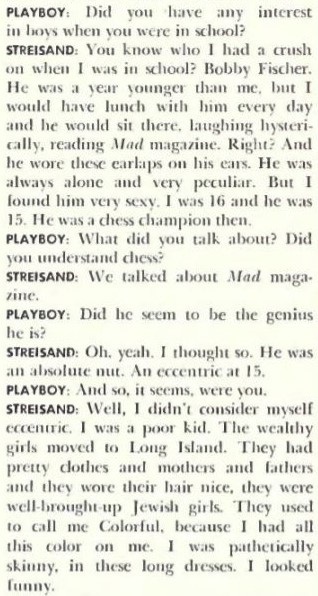
11268. Pillsbury in hospital
The report below on Harry Nelson Pillsbury, from pages 1 and 4 of the Philadelphia Inquirer, 1 April 1905, was presented in C.N. 1696 courtesy of Jeremy Gaige (Philadelphia, PA, USA):

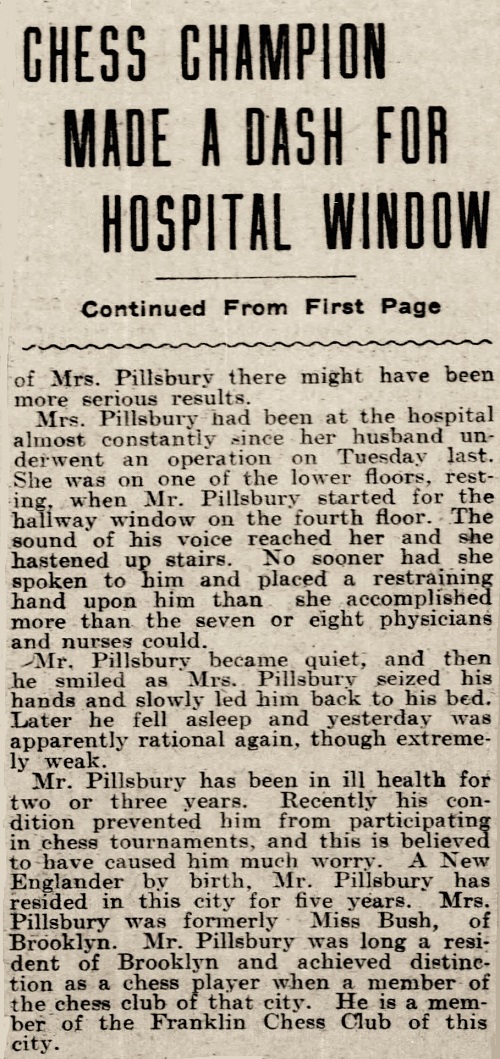
11269. Exceptional games
C.N. 11259 referred to Wolfgang Heidenfeld’s description of Śliwa v Bronstein, Gotha, 1957 as the ‘immortal loss’. In the same source (page 271 of the September 1965 BCM) Heidenfeld called Bronstein v Keres, Göteborg, 1955 ‘probably the most profound game ever’. Minić v Tolush, Oberhausen, 1961 was ‘the most fantastic defensive win’. He also praised the ‘beautifully played’ game Mikėnas v Lebedev, Tbilisi, 1941.
11270. Facts, non-facts and interpretations (C.N. 11265)
C.N. 11265 showed that unjustified interpretations about Paul Morphy’s conduct were made by Reinfeld and by CHESS in ignorance of the facts. Concerning the Colonel Mead yarn, we now reproduce the relevant pages of Paul Morphy. His Later Life by C.A. Buck (Newport, 1902):
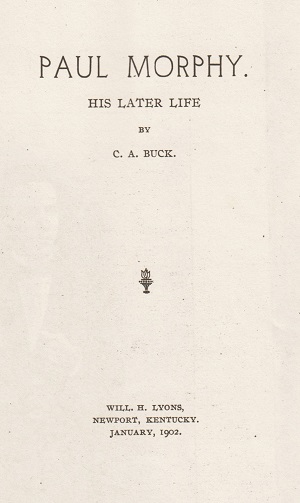
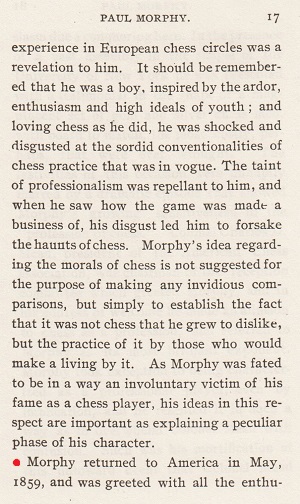
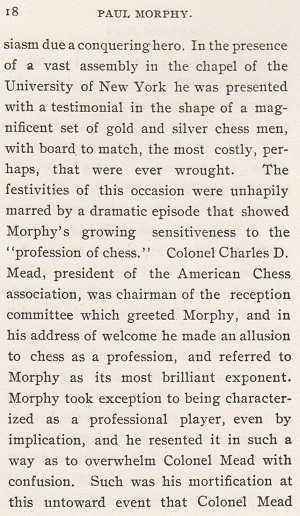
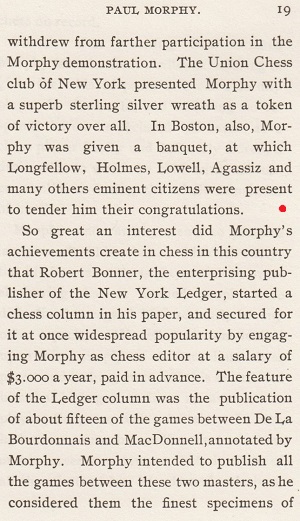
Below is the repudiation of Buck’s claim on pages 213-214 of Paul Morphy The Pride and Sorrow of Chess by David Lawson (New York, 1976):
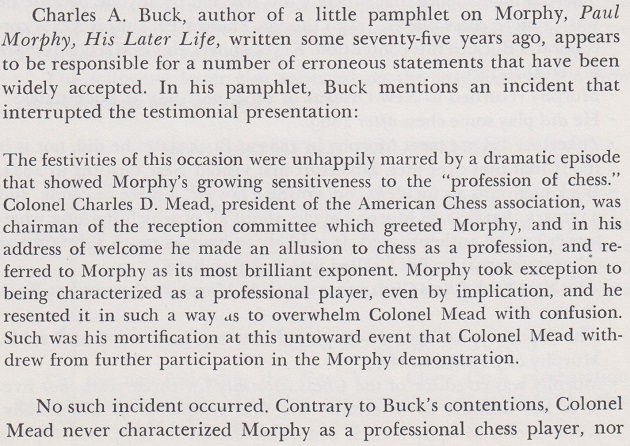
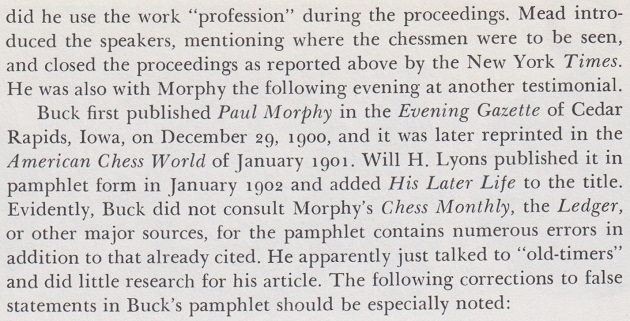
In bullet-point form on pages 214-215 Lawson then listed 16 corrections to Buck’s booklet, the final one being:

The episode illustrates how chess history has often been distorted, with false inferences drawn. The unsubstantiated claims by Buck were repeated by Reinfeld without dissent or attribution. Although the CHESS review of The Human Side of Chess criticized Reinfeld in general terms for rough-handling evidence, it accepted unquestioningly what Reinfeld had written about Colonel Mead. Solely on that basis, CHESS denounced Morphy for conduct that was ‘insanely cruel’.
11271. Articles by Juan Corzo
C.N. 11260 gave an article by Juan Corzo y Príncipe on page 17 of Carteles, 9 October 1927. Two further pieces by him in the same Cuban publication:
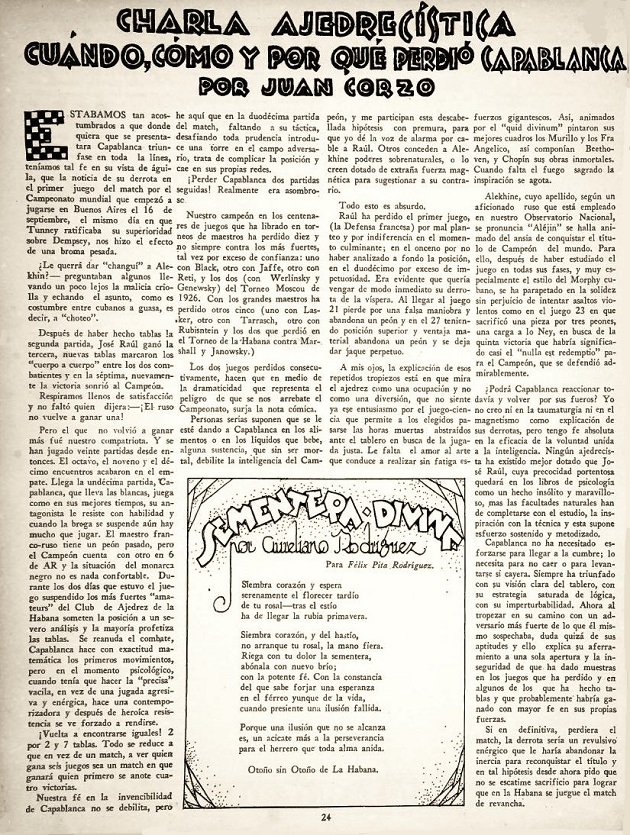
Carteles, 20 November 1927, page 24
11272. Capablanca’s memory
On the subject of memory, an unverified claim was published on page 16 of the Scranton Tribune, 10 May 1937:
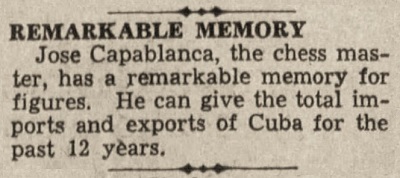
11273. James Mortimer
The latest feature article is James Mortimer: Chessplayer and Playwright.
11274. Prague, 1905
A good-quality version of a familiar photograph:
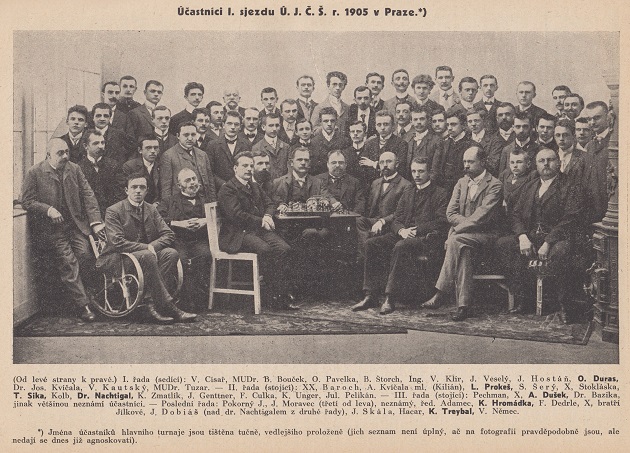
Source: Šach, July 1940, page 99.
11275. Levitzky v Marshall
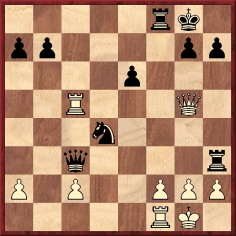
Black played 23...Qg3, and White resigned.
When Marshall’s ‘Gold Coins’ Game was published on page 16 of the Manchester Guardian, 30 July 1912, Gunsberg wrote of 23...Qg3:
‘One of the strangest moves that any player can make, though again fairly obvious after seeing it.’
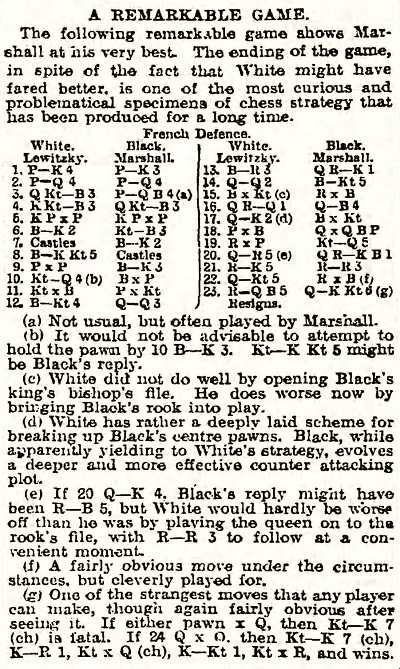
| First column | << previous | Archives [176] | next >> | Current column |
Copyright: Edward Winter. All rights reserved.
